Click image for BBB rating
See our Privacy Policy
cool="cool" width="785" height="6080" border="0" cellpadding="0" cellspacing="0" gridx="16" showgridx="showgridx" usegridx="usegridx" gridy="16" showgridy="showgridy" usegridy="usegridy" bgcolor="#99ccff">
|
|
|
 |
|
|
|
|
|
|
Welcome to Spaightwood Galleries, Inc.
120 Main Street, Upton MA 01568-6193
You can follow us on Facebook and Twitter!
We blog regularly on Facebook and announce special events and special sales on both sites.
Old Master Images from the Bible: Esther
|
|
|
|
|
|
|
|
|
|
|
|
The story of Esther is told in the Book of Esther in the Old Testament, a story that results in the destruction of those who would destroy the Jews and the institution of a holiday, Purim, whose purpose is to celebrate God's goodness for saving his people from assured destruction at the hands of the evil, proud, and greedy Haman, chief minister of the King, through the agency of a young and at times fearful young woman, Esther, an orphan who beomes the Queen of Persia and the wife of Ahasuerus (Xerxes, King of Persia from 485-464 B.C.). The story begins with Queen Vashti insulting the King by refusing to come to his feast at his request for which the King decides to put her aside and launches a hunt for a new Queen by requiring the all the young women in the kingdom be purified and come before him: "Now when the turn of Esther, the daughter of Abihail the uncle of Mordecai, who had taken her for his daughter, was come to go in unto the king, she required nothing but what Hegai the king’s chamberlain, the keeper of the women, appointed. And Esther obtained favour in the sight of all them that looked upon her. So Esther was taken unto king Ahasuerus into his house royal in the tenth month, which is the month Tebeth, in the seventh year of his reign. And the king loved Esther above all the women, and she obtained grace and favour in his sight more than all the virgins; so that he set the royal crown upon her head, and made her queen instead of Vashti. Then the king made a great feast unto all his princes and his servants, even Esther’s feast; and he made a release to the provinces, and gave gifts, according to the state of the king" (Esther 2:15-18).
|
|
|
|
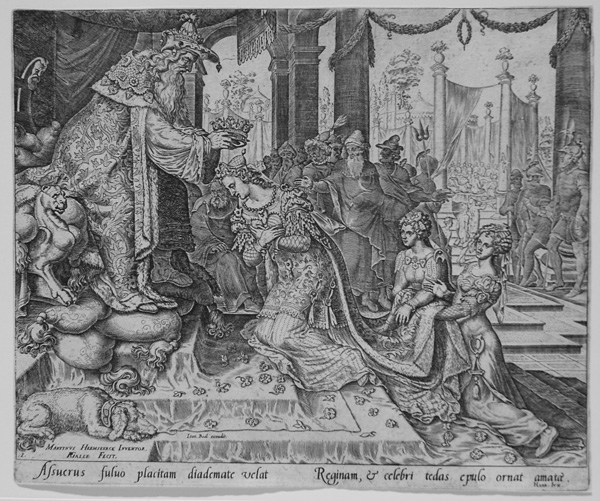 |
|
|
Philips Galle (Antwerp, 1537-1612), Ahasuerus makes Esther his Queen (The Illustrated Bartsch 5601.017:1 iii/iv ). Engraving after Maerten van Heemskerck, 1564. Very good impression on laid paper with thread margins. From The Story of Esther. Inscribed: "1 / Martinvs Heemskerck Inventor, PGalle Fecit" (lower left); "Ioan. Boel excudit" (on dais left center). Originally published by Hieronymous Cock in 1564, this is from an early 17th-century printing by Jan Boel. Image size: 203x246mm. Price: Please call or email for current pricing information.
|
|
|
|
|
Like a responsible parent, Modecai comes daily to the court to be sure that Esther is okay, in the process discovering a plot against the life of the king by two court guards. Mordecai informs the king, the guards are executed, and Mordecai's act is recorded in the King's chronicle of events. Meanwhile "Haman the son of Hammedatha the Agagite, and advanced him, and set his seat above all the princes that were with him. And all the king’s servants, that were in the king’s gate, bowed, and reverenced Haman: for the king had so commanded concerning him. But Mordecai bowed not, nor did him reverence. Then the king’s servants, which were in the king’s gate, said unto Mordecai, Why transgressest thou the king’s commandment? Now it came to pass, when they spake daily unto him, and he hearkened not unto them, that they told Haman, to see whether Mordecai’s matters would stand: for he had told them that he was a Jew. And when Haman saw that Mordecai bowed not, nor did him reverence, then was Haman full of wrath. And he thought scorn to lay hands on Mordecai alone; for they had shown him the people of Mordecai: wherefore Haman sought to destroy all the Jews that were throughout the whole kingdom of Ahasuerus, even the people of Mordecai. . . . And Haman said unto king Ahasuerus, There is a certain people scattered abroad and dispersed among the people in all the provinces of thy kingdom; and their laws are diverse from all people; neither keep they the king’s laws: therefore it is not for the king’s profit to suffer them. If it please the king, let it be written that they may be destroyed: and I will pay ten thousand talents of silver to the hands of those that have the charge of the business, to bring it into the king’s treasuries. And the king took his ring from his hand, and gave it unto Haman the son of Hammedatha the Agagite, the Jews’ enemy" (Esther 3:1-3:10). Haman has aproclamation published announcing the destruction of the Jews and the news comes to Mordecai. "When Mordecai perceived all that was done, Mordecai rent his clothes, and put on sackcloth with ashes, and went out into the midst of the city, and cried with a loud and a bitter cry; And came even before the king’s gate: for none might enter into the king’s gate clothed with sackcloth. And in every province, whithersoever the king’s commandment and his decree came, there was great mourning among the Jews, and fasting, and weeping, and wailing; and many lay in sackcloth and ashes. So Esther’s maids and her chamberlains came and told it her. Then was the queen exceedingly grieved; and she sent raiment to clothe Mordecai, and to take away his sackcloth from him: but he received it not" (Esther 4:1-4:4).
|
|
|
|
|
|
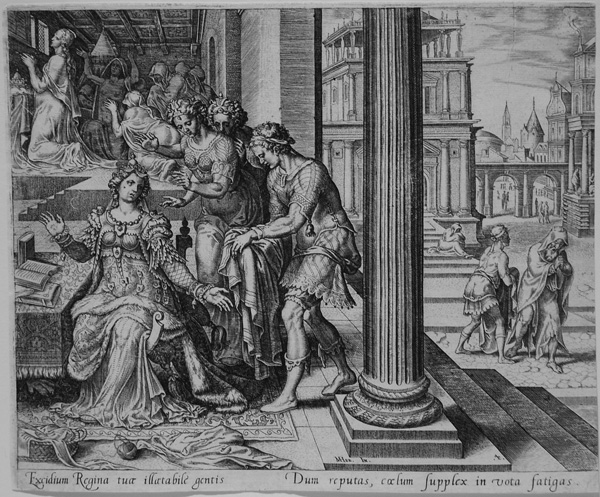 |
|
|
Philips Galle (Antwerp, 1537-1612), Esther told that Mordecai refuses the Raiment (The Illustrated Bartsch 5601.017:4 i/iii). Engraving after Maerten van Heemskerck, 1564. Very good impression on laid paper with thread margins. Plate 4 of The Story of Esther. Inscribed: "MHee. In.: (base of column, right of center). Trimmed within platemark right side; thread margins top, bottom, and left. Published by Hieronymous Cock in 1564. This series proved very popular and two additional printings were made. Image size: 204x240mm. Price: Please call or email for current pricing information.
|
|
|
|
|
Instead of entering the court, Mordecai sends her a message: "And Mordecai told him of all that had happened unto him, and of the sum of the money that Haman had promised to pay to the king’s treasuries for the Jews, to destroy them. Also he gave him the copy of the writing of the decree that was given at Shushan to destroy them, to show it unto Esther, and to declare it unto her, and to charge her that she should go in unto the king, to make supplication unto him, and to make request before him for her people. And Hatach came and told Esther the words of Mordecai. Again Esther spake unto Hatach, and gave him commandment unto Mordecai; All the king’s servants, and the people of the king’s provinces, do know, that whosoever, whether man or woman, shall come unto the king into the inner court, who is not called, there is one law of his to put him to death, except such to whom the king shall hold out the golden sceptre, that he may live: but I have not been called to come in unto the king these thirty days. And they told to Mordecai Esther’s words. Then Mordecai commanded to answer Esther, Think not with thyself that thou shalt escape in the king’s house, more than all the Jews. For if thou altogether holdest thy peace at this time, then shall there enlargement and deliverance arise to the Jews from another place; but thou and thy father’s house shall be destroyed: and who knoweth whether thou art come to the kingdom for such a time as this? Then Esther bade them return Mordecai this answer, Go, gather together all the Jews that are present in Shushan, and fast ye for me, and neither eat nor drink three days, night or day: I also and my maidens will fast likewise; and so will I go in unto the king, which is not according to the law: and if I perish, I perish" (Esther 4:7-4:16).
|
|
|
|
|
|
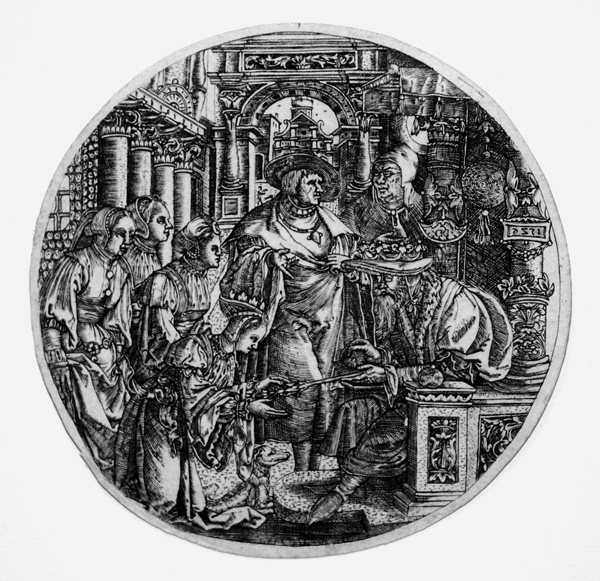 |
|
Master DD (active Netherlands c. 1526-1552) Esther before Ahasuerus, c. 1526. Master DD was a goldsmith active in the Netherlands between 1526 and 1552. His only known work is a round silver plate, one side with Esther and Ahasuerus, the other Esther and Mordecai. Ours is one of only a few known proofs taken from that silver plate. Very Rare! Image size: 63°mm. Price: Please call or email for current pricing information.
|
|
|
|
|
|
|
When Esther comes before the king and waits silently, he hold out his golden scepter to her and invites her to speak: "when the king saw Esther the queen standing in the court, that she obtained favour in his sight: and the king held out to Esther the golden sceptre that was in his hand. So Esther drew near, and touched the top of the sceptre. Then said the king unto her, What wilt thou, queen Esther? and what is thy request? it shall be even given thee to the half of the kingdom. And Esther answered, If it seem good unto the king, let the king and Haman come this day unto the banquet that I have prepared for him. Then the king said, Cause Haman to make haste, that he may do as Esther hath said. So the king and Haman came to the banquet that Esther had prepared. And the king said unto Esther at the banquet of wine, What is thy petition? and it shall be granted thee: and what is thy request? even to the half of the kingdom it shall be performed. Then answered Esther, and said, My petition and my request is: If I have found favour in the sight of the king, and if it please the king to grant my petition, and to perform my request, let the king and Haman come to the banquet that I shall prepare for them, and I will do tomorrow as the king hath said: (Esther 5:2-5:8). Haman returns to his home, pleased with this sign of favor, his good mood spoiled only by the sight of Mordecai: "Then said Zeresh his wife and all his friends unto him, Let a gallows be made of fifty cubits high, and tomorrow speak thou unto the king that Mordecai may be hanged thereon: then go thou in merrily with the king unto the banquet. And the thing pleased Haman; and he caused the gallows to be made" (Esther 5:14). Meanwhile the king, sleepless with anticipation, calls for the great chronicle of his reign, and discovers that Mordecai has not yet been rewarded for saving his life. He calls for Haman: "On that night could not the king sleep, and he commanded to bring the book of records of the chronicles; and they were read before the king. And it was found written, that Mordecai had told of Bigthana and Teresh, two of the king’s chamberlains, the keepers of the door, who sought to lay hand on the king Ahasuerus. And the king said, What honour and dignity hath been done to Mordecai for this? Then said the king’s servants that ministered unto him, There is nothing done for him. And the king said, Who is in the court? Now Haman was come into the outward court of the king’s house, to speak unto the king to hang Mordecai on the gallows that he had prepared for him. And the king’s servants said unto him, Behold, Haman standeth in the court. And the king said, Let him come in. So Haman came in. And the king said unto him, What shall be done unto the man whom the king delighteth to honour? Now Haman thought in his heart, To whom would the king delight to do honour more than to myself? And Haman answered the king, For the man whom the king delighteth to honour, Let the royal apparel be brought which the king useth to wear, and the horse that the king rideth upon, and the crown royal which is set upon his head: And let this apparel and horse be delivered to the hand of one of the king’s most noble princes, that they may array the man withal whom the king delighteth to honour, and bring him on horseback through the street of the city, and proclaim before him, Thus shall it be done to the man whom the king delighteth to honour" (Esther 6:1-6).
|
|
|
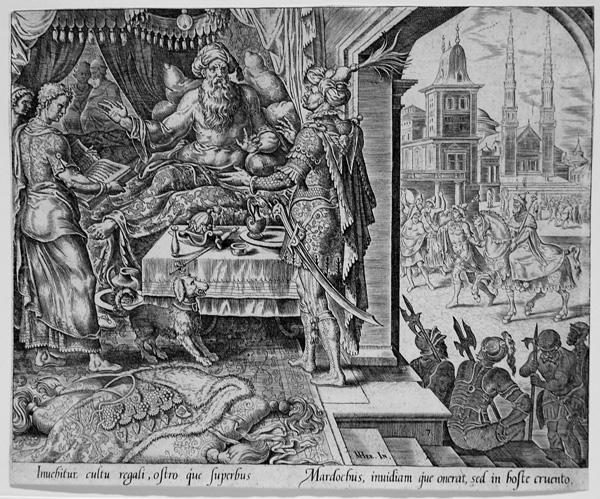 |
|
|
|
Philips Galle (Antwerp, 1537-1612), Ahasuerus consulting Haman (The Illustrated Bartsch 5601.017:7 i/iii). Engraving after Maerten van Heemskerck, 1564. Very good impression on laid paper with thread margins. Plate 7 of The Story of Esther. Inscribed: "Hee. In." (on stairs leading to the right). Trimmed on or within the platemark. First published by Hieronymous Cock in 1564. This series proved very popular and two additional printings were made. Image size:201x246mm. Price: Please call or email for current pricing information.
|
|
|
|
|
In the denouement, all of Haman's plots rebound upon his head. The honors he dreamed of for himself are done to Mordecai, the gibbet he had built for Mordeci's hanging ends up being used to send him from this world, the slaughter he had planned to inflict upon the Jews is visited instead upon all of his followers, and the celebrations he had expected to follow his vctories are replaced by an annual festival: "Therefore the Jews of the villages, that dwelt in the unwalled towns, made the fourteenth day of the month Adar a day of gladness and feasting, and a good day, and of sending portions one to another. And Mordecai wrote these things, and sent letters unto all the Jews that were in all the provinces of the king Ahasuerus, both nigh and far, To stablish this among them, that they should keep the fourteenth day of the month Adar, and the fifteenth day of the same, yearly, As the days wherein the Jews rested from their enemies, and the month which was turned unto them from sorrow to joy, and from mourning into a good day: that they should make them days of feasting and joy, and of sending portions one to another, and gifts to the poor. And the Jews undertook to do as they had begun, and as Mordecai had written unto them; Because Haman the son of Hammedatha, the Agagite, the enemy of all the Jews, had devised against the Jews to destroy them, and had cast Pur, that is, the lot, to consume them, and to destroy them; But when Esther came before the king, he commanded by letters that his wicked device, which he devised against the Jews, should return upon his own head, and that he and his sons should be hanged on the gallows. Wherefore they called these days Purim after the name of Pur. Therefore for all the words of this letter, and of that which they had seen concerning this matter, and which had come unto them, The Jews ordained, and took upon them, and upon their seed, and upon all such as joined themselves unto them, so as it should not fail, that they would keep these two days according to their writing, and according to their appointed time every year; And that these days should be remembered and kept throughout every generation, every family, every province, and every city; and that these days of Purim should not fail from among the Jews, nor the memorial of them perish from their seed. Then Esther the queen, the daughter of Abihail, and Mordecai the Jew, wrote with all authority, to confirm this second letter of Purim. And he sent the letters unto all the Jews, to the hundred twenty and seven provinces of the kingdom of Ahasuerus, with words of peace and truth, To confirm these days of Purim in their times appointed, according as Mordecai the Jew and Esther the queen had enjoined them, and as they had decreed for themselves and for their seed, the matters of the fastings and their cry. And the decree of Esther confirmed these matters of Purim; and it was written in the book. (Esther 9:19--9:32).
|
|
|
|
|
|
|
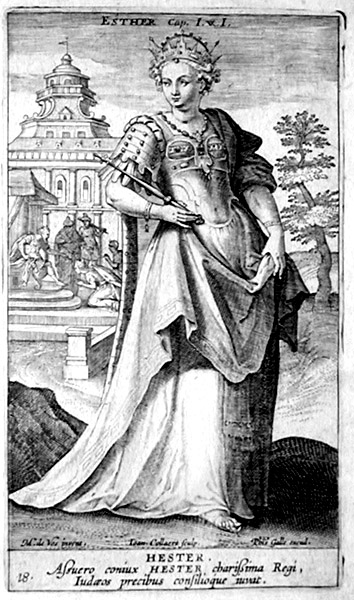 |
|
Hans (Jan) Collaert (Antwerp, 1566-1628), Hester (New Holl. de Vos 240 ii/ii). Engraving after Marten de Vos, c. 1581. Plate 18 from a set of Celebrated Women of the Old Testament consisting of twenty engravings (plus frontispiece) by Hans or Adrien Collaert and Carel van Mallery published in Antwerp by Phillip Galle (1537-1612). Ahasuerus, King of Persia, puts aside his wife Vashti because she refuses to come when he sends for her (his council think that such disobedience unpunished wouled lead all wives to act the same way with their husbands) and seeks a new wife, choosing the beautiful Esther, niece of Mordecai. Mordecai learns of a plot to kill the king and through Esther warns the king who is saved as a consequence. Shortly afterwards one of the King's nobles, Haman, becomes offended with Mordecai, who refuses to prostrate himself before Haman, and seeks for his life and the lives of all Jews since Mordecai is a Jew. Esther, following Mordecai's advice, had never informed her husband of her religion. Now, coming uninvited into his presence (for which the penalty is death), she invites him to dinner and pleads for her life and the life of her people. Haman, who had built a 75-foot tall gallows on which he had planned to hang Mordecai, finds himself hung there instead, and Mordecai, for saving the King's life, gets Haman's office. Through her disobedience, Esther saves her people. Image size: 154x88mm. Price: Please call or email for current pricing information.
|
|
|
|
Spaightwood Galleries, Inc.
To purchase, call us at 1-800-809-3343 (1-508-529-2511 in Upton MA & vicinity) or send an email to spaightwood@gmail.com.
We accept AmericanExpress, DiscoverCard, MasterCard, and Visa.
We also accept wire transfers and paypal.
For directions and visiting information, please call. We are, of course, always available over the web and by telephone (see above for contact information). Click the following for links to past shows and artists. For a visual tour of the gallery, please click here. For information about Andy Weiner and Sonja Hansard-Weiner, please click here. For a list of special offers currently available, see Specials.
All works are sold with an unconditional guarantee of authenticity (as described in our website listing).
Go back to the top of this page.
Visiting hours: Saturday 10:00 am to 5:00 pm and Sunday noon to 6:00 pm and other times by arrangement.
Please call to confirm your visit. Browsers and guests are welcome.
|
|
|
|
|
|
|
|
|
|
|
|
|
|
|
|
|
|
|
|
|
|
|
|
|
|
|
|
|
|
|
|
|
|
|




